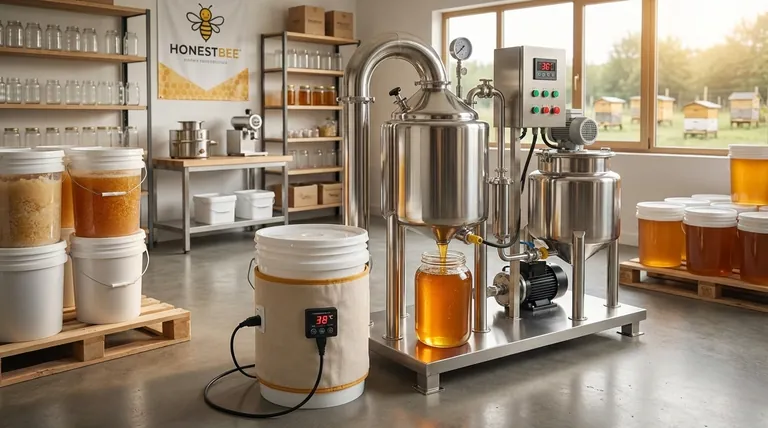Honey bucket warmers are precision tools designed to reverse crystallization and restore honey to a liquid state without damaging its quality. By applying low, consistent heat evenly around the container, they eliminate the "hot spots" common with other heating methods, ensuring the honey remains pourable while preserving its delicate enzymes, flavor, and natural properties.
The core challenge in honey storage is managing its natural tendency to crystallize. A bucket warmer is not for long-term storage heating; it is a specialized tool for gently and safely re-liquefying honey that has already crystallized, making it manageable for bottling or use.

The Core Problem: Crystallization vs. Quality
Honey's high sugar concentration makes it prone to crystallization, a natural process that does not indicate spoilage. However, reversing this process improperly can permanently damage the honey.
Why Uncontrolled Heating is Damaging
Applying high or uneven heat—such as from a heat gun or by placing a bucket in hot water—creates hot spots.
These concentrated areas of high temperature can scorch the honey, leading to caramelization, a darkened color, and a burnt flavor. More importantly, this overheating destroys the beneficial enzymes and antioxidants that define raw honey's quality.
How a Warmer Provides a Solution
A honey bucket warmer, typically a wrap-around blanket, is engineered for one specific task: uniform heat distribution.
It gently raises the temperature of the entire container at a slow, controlled rate. This melts the sugar crystals evenly without ever overheating any single part of the honey, thus protecting its delicate composition.
Understanding the Trade-offs and Best Practices
Using a warmer is a corrective action, not a preventative storage method. The best approach involves understanding how to store honey and when to use a warmer effectively.
The Right Temperature: A Balancing Act
The goal is to gently warm the honey just enough to dissolve the crystals, typically to a temperature no higher than 104°F (40°C).
Exceeding this range for prolonged periods risks degrading the honey's natural properties, even with a proper warmer. Patience is key; warming a 5-gallon bucket can take 24 hours or more.
The Critical Role of the Container
The container material significantly impacts long-term quality, as stated in the reference.
Glass is the ideal material for long-term storage because it is impermeable, preventing moisture exchange and protecting the honey's integrity.
Plastic, while practical, can be slightly permeable. Over long periods, this can allow for gradual moisture loss, which may accelerate crystallization.
Avoiding Light and Moisture
Regardless of the container, honey must be stored with an airtight seal. Exposure to air introduces moisture, which can increase the risk of fermentation.
Furthermore, exposure to UV light degrades honey over time. Using opaque or dark-colored containers is a crucial step in preserving quality during long-term storage.
Making the Right Choice for Your Goal
Your storage strategy should align with your intended use for the honey. A warmer is a tool for processing, not a permanent part of storage.
- If your primary focus is long-term preservation: Store honey in an airtight, dark glass container in a cool, stable environment to slow crystallization naturally.
- If your primary focus is immediate bottling or use: Use a honey bucket warmer on a low setting to gently re-liquefy crystallized honey as needed.
- If your primary focus is commercial efficiency: A warmer is an essential tool for preparing large quantities of crystallized honey for bottling, ensuring a consistent and pourable product without sacrificing quality.
Ultimately, proper honey management is about using the right tool at the right time to protect its value.
Summary Table:
| Key Aspect | Role of a Honey Bucket Warmer |
|---|---|
| Primary Function | Gently re-liquefies crystallized honey for bottling or use. |
| Heat Distribution | Provides uniform, low heat to prevent damaging hot spots. |
| Quality Preservation | Protects delicate enzymes, flavor, and color by staying below 104°F (40°C). |
| Best Practice | A corrective tool for processing, not for long-term storage heating. |
Ensure your honey is consistently pourable and high-quality for your customers. HONESTBEE supplies commercial apiaries and beekeeping equipment distributors with reliable, wholesale-focused honey processing equipment like bucket warmers. Let us help you protect your product's value and streamline your bottling process. Contact our experts today to discuss your commercial beekeeping supply needs.
Visual Guide

Related Products
- 0.5T Capacity Honey Dehumidifier Dryer with Vacuum Heating and Thickening Filtering Machine
- 10L Stainless Steel Electric Honey Press Machine
- High Quality Honey Dehumidifier Dryer Thickening Machine for Beekeeping
- Beeswax Melter for Candle Making Honey Bee Wax Melter
- HONESTBEE 72 Frame Industrial Electric Honey Extractor for Beekeeping
People Also Ask
- What are the benefits of using a honey dryer for honey production? Boost Yield & Quality
- What is the role of heated air in a honey dryer? Gentle Moisture Control for Premium Honey Quality
- How to extract uncapped honey? Salvage Your Harvest and Prevent Fermentation
- What is the recommended drying temperature and moisture content for honey? Preserve Quality & Prevent Fermentation
- What principle does the honey vacuum thickener use to concentrate honey? Preserve Quality with Low-Temperature Evaporation



















